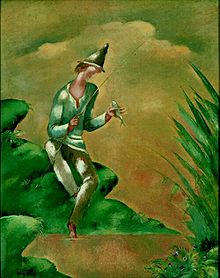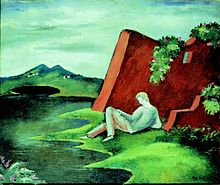Eugeniusz Zak
Eugeniusz Zak , actually Eugeniusz Żak, (born December 15, 1884 in Mogilno, Russian Empire , † January 15, 1926 in Paris ) was a Polish painter and an important representative of the École de Paris .
Life
Eugeniusz Zak came from a Polish-Jewish family who lived in Mogilno in the Minsk Governorate (now Belarus). His father was an engineer. As a child, he moved to Warsaw in 1892 , where he graduated from high school. In 1902 he went to Paris for artistic training - first at the École des Beaux-Arts in the studio of Jean-Léon Gérôme , then at the Académie Colarossi under Albert Besnard . In 1903 he traveled to Italy and finally attended the private painting school of the Slovenian artist Anton Ažbes in Munich for a short time .
In 1904 he returned to Paris. In the same year he made his debut in the autumn exhibition of the Paris Salon . Just two years later he was to be a member of the jury (drawing section). From 1906 to 1908 he traveled to Brittany several times . In Paris he was active in the Polish artists' colony and was a member of the Society of Polish Artists in Paris . He was friends with Roman Kramsztyk , Wacław Borowski , Leopold Gottlieb , Elie Nadelman , Mela Muter , Tytus Czyżewski and Zygmunt Menkes .
Zak quickly became known. The French state acquired one of his paintings for the Musée du Luxembourg in Paris in 1910 and in 1911 a solo exhibition took place in the renowned Parisian Galerie Druet. He had a close relationship with important art critics such as Adolphe Basler and André Salmon , who promoted him. In 1912 he was appointed professor at the Académie de la Palette . In 1913 he married Jadwiga Kon. He spent the period between 1914 and 1916 in the south of France ( Nice and Saint Paul de Vence ) and Venice . He also visited Lausanne .
In 1916 he returned to Poland with his family and settled in Częstochowa , his wife's hometown. He became a supporter of the future "formists". On the occasion of regular visits to Warsaw and contacts in the local art scene, he co-founded the group Rhythm (Polish: "Rytm") in 1921 . In 1922 he left Poland again. After a stay in Berlin he was in Bonn , where he executed paintings in the villa of the architect Fritz August Breuhaus . He also published articles in the magazine "German Art and Decoration". In 1923 he moved back to Paris, where he met Zygmunt Menkes and Marc Chagall again. Zak died of a heart attack in 1926 .
plant
In an early period (1904 to 1910) Zak painted portraits in oils with brown-black tones, as well as heads and busts influenced by the work of artists such as Leonardo da Vinci , Sandro Botticelli , Michelangelo , Albrecht Dürer and François Clouet . Later, echoes of the style of the Nabis representatives can be recognized. Folkloric elements of Brittany can be found in other images. From 1910 to 1929 he created many idyllic compositions, often with people in front of a body of water. Landscapes and architecture are presented in a geometric and rhythmic style. Reminiscences of works by Pierre Puvis de Chavannes or Maurice Denis or Paul Cézanne can be seen in this period . Zak always composed his cubist- style houses and stone masses with his own decorative rhythm of broken colors and reserved expression. In the works that he created between 1917 and 1920, loners who were removed from society and appeared depressed often replaced the lifelike figures of fishermen, sailors, merchants or families that were previously used. In his last creative period the works became more light and cheerful again. They are partially open to impressionism . The techniques and forms used by Zak are characteristic of his work and give his pictures a high recognition factor.
Exhibitions
During his lifetime, the artist held solo exhibitions in Paris (1911 and 1925) and Warsaw (1917). His works were shown at the exhibition of the Paris Salon in 1904 and at a performance by Polish artists from Paris in Barcelona in 1912. Zak exhibited in 1913 at the Armory Shows in New York , Chicago and Boston , in 1914 at the Venice Biennale and in 1924 at the Paris exhibitions of the French-Polish association ("Association France-Pologne"). In Poland he was represented in exhibitions of the groups and associations “Sztuka”, “Rytm”, Polish Art Club (Polish: “Polski Klub Artystyczny”), New Group and the artist community later known as “ Formists ”.
Posthumous exhibitions were organized in 1926 in Paris, Warsaw and Düsseldorf , 1927 in New York, 1928 in Buffalo and 1929 in London . Likewise, the “Galerie Zak” run by his wife in Paris after his death showed his works several times. This gallery was very reputable in the 1930s and held many debut exhibitions, such as for the Paris Committee or Wassily Kandinsky .
References and comments
- ↑ a b c d Original title unknown
- ↑ Map of the place and further information at www.jewishgen.org
- ↑ a b c d according to Irena Kossowska, detailed biography ( page no longer available , search in web archives ) Info: The link was automatically marked as defective. Please check the link according to the instructions and then remove this notice. at Culture.pl (in English)
- ^ Adolphe Basler was a Polish painter and art critic. From Paris he reported for the German avant-garde magazine “ Die Aktion ”.
- ↑ regarding his first solo exhibition in Paris
literature
- Władysława Jaworska, Agnieszka Morawińska and others, Malarstwo polskie w kolekcji Ewy i Wojciecha Fibakow ( Polish painting in the Ewa and Wojtek Fibak Collection ), Auriga Publishing House, Warsaw 1992, ISBN 83-221-0623-8 , p. 148ff.
Web links
| personal data | |
|---|---|
| SURNAME | Zak, Eugeniusz |
| ALTERNATIVE NAMES | Żak, Eugeniusz (real name) |
| SHORT DESCRIPTION | Polish painter |
| DATE OF BIRTH | December 15, 1884 |
| PLACE OF BIRTH | Mogilno |
| DATE OF DEATH | January 15, 1926 |
| Place of death | Paris |




